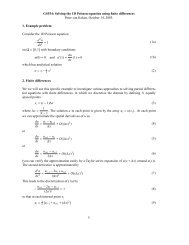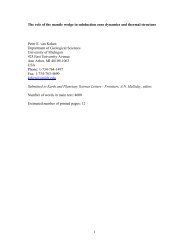Quantitative paleoenvironmental and paleoclimatic reconstruction ...
Quantitative paleoenvironmental and paleoclimatic reconstruction ...
Quantitative paleoenvironmental and paleoclimatic reconstruction ...
You also want an ePaper? Increase the reach of your titles
YUMPU automatically turns print PDFs into web optimized ePapers that Google loves.
ARTICLE IN PRESS<br />
N.D. Sheldon, N.J. Tabor / Earth-Science Reviews xxx (2009) xxx–xxx<br />
41<br />
1,5-biphosphate (RuBP) <strong>and</strong> the enzyme Rubisco, the 3-carbon sugar<br />
glyceraldhydes-3-phosphate (G3P) is produced (Tipple <strong>and</strong> Pagani,<br />
2007). For each six G3P molecules produced, one molecule is converted<br />
to a simple sugar for cell use <strong>and</strong> the remaining five are<br />
recycled to generate more RuBP (Tipple <strong>and</strong> Pagani, 2007). Under<br />
environmentally stressful conditions such as high temperature,<br />
aridity, or high-light intensity, leaves close their stomatal openings<br />
<strong>and</strong> consequently, have lower internal CO 2 concentrations, which<br />
reduces the efficiency of C 3 photosynthesis. Two other photosynthetic<br />
pathways have evolved in terrestrial vascular plants: 1) Crassulacean<br />
acid metabolism (CAM), which is used primarily by succulents <strong>and</strong><br />
2) C 4 photosynthesis, which is used primarily by dry- <strong>and</strong> cold-climate<br />
grasses. Ultimately, C 4 photosynthesis uses the Calvin–Benson cycle to<br />
fix C, but a series of intermediate storage reactions increase the overall<br />
photosynthetic efficiency under environmentally stressed conditions<br />
by storing CO 2 as HCO 3 − that can be re-converted to CO 2 for use at the<br />
optimally efficient time (Tipple <strong>and</strong> Pagani, 2007).<br />
This difference between photosynthetic pathways is recorded by<br />
paleosol carbonates <strong>and</strong> organic matter because of differences in how<br />
strongly the two pathways discriminate against 13 C. C 3 photosynthesis<br />
discriminates more strongly, which results in typical biomass δ 13 C<br />
values of − 20‰ to − 33‰ (mean − 27‰), whereas C 4 photosynthesis<br />
does not discriminate strongly, which results in typical biomass<br />
δ 13 C values of −10‰ to −14‰ (mean −13‰) (e.g., Koch, 1998;<br />
Cerling <strong>and</strong> Harris, 1999). The δ 13 C value of soil biomass is directly<br />
related to δ 13 C values of soil-respired CO 2 <strong>and</strong> pedogenic calcite (see<br />
Sections 7.1–7.4). Owing to a variety of factors (reviewed in Koch, 1998<br />
<strong>and</strong> discussed above) soil calcite is typically 14‰–17‰ more positive<br />
(i.e., 13 C-enriched) relative to soil-respired CO 2 . CAM plants are relatively<br />
rare, so most soil organic matter is derived either from C 3 or C 4<br />
photosynthesis. Thus, using either δ 13 C org or δ 13 C cc values, it is possible<br />
to derive a simple two-component mixing line between C 3 <strong>and</strong> C 4<br />
photosynthetic pathways, <strong>and</strong> consequently, vegetation types since C 4<br />
plants are typically grasses (though it should be noted that there are<br />
also a number of C 3 grasses).<br />
For pedogenic carbonates (<strong>and</strong> assuming an enrichment factor<br />
[Δ 13 C] of 15.5‰ (e.g., Fox <strong>and</strong> Koch, 2003), the proposed mixing line is<br />
between −11.5‰ (100% C 3 ) <strong>and</strong> +2.5‰ (100% C 4 ). Using this equation,<br />
or a similar one, various authors have reconstructed the balance<br />
between C 3 <strong>and</strong> C 4 plants during the Cenozoic in areas including East<br />
Africa, Pakistan, Greece, <strong>and</strong> North <strong>and</strong> South America (Quade et al.,<br />
1989, 1994; Cerling <strong>and</strong> Quade, 1993; Cerling, 1992; Cerling et al.,<br />
1993; Kingston et al., 1994; Latorre et al., 1997; Fox <strong>and</strong> Koch, 2003,<br />
2004) <strong>and</strong> have concluded that there was a significant expansion of<br />
the amount <strong>and</strong> range of C 4 plants in the late Miocene (e.g., Fig. 19).<br />
Those results are further supported by analyses of mammal diets in<br />
many of the same areas, <strong>and</strong> which indicate a similar shift toward C 4<br />
plants (e.g., Passey et al., 2002; Cerling et al., 1997). Though all of the<br />
studies indicated a late Miocene age for the spread of C 4 plants (at the<br />
expense of C 3 plants), the timing of the spread is regionally dependent<br />
(see Fig. 5 of Tipple <strong>and</strong> Pagani, 2007), <strong>and</strong> in North America, some<br />
component of C 4 plants was probably present much earlier in the<br />
Miocene (Fox <strong>and</strong> Koch, 2003, 2004; Sheldon, 2008).<br />
The limitations to this approach have been discussed in various<br />
places (e.g., Koch, 1998; Fox <strong>and</strong> Koch, 2003), but there are three<br />
principle factors to consider when reconstructing the C 3 –C 4 plant<br />
balance using paleosols. The first is aridity, which could potentially<br />
shift the δ 13 C composition of C 3 biomass toward heavier values, which<br />
would give a false-positive C 4 plant result. As discussed in Section 5.5,<br />
there are various methods for reconstructing past precipitation<br />
regimes using paleosols, so it should be possible to account for this<br />
effect. Secondly, high levels of atmospheric CO 2 would result in higher<br />
concentrations of atmospheric CO 2 in the soil, a corresponding shift<br />
toward more positive δ 13 C cc values, <strong>and</strong> an overestimate of C 4<br />
photosynthesizers. However, various marine <strong>and</strong> non-marine proxies<br />
(e.g., Royer et al., 2004) indicate at most slight elevated CO 2 levels<br />
through the Neogene above pre-industrial levels, so unless evidence<br />
for earlier C 4 plants is discovered, the entire period of time in which<br />
the C 3 –C 4 balance is a viable research avenue is characterized by “low”<br />
CO 2 levels. The final potential issue is with low productivity soils,<br />
which would also have heavier δ 13 C values, low concentrations of CO 2<br />
derived from oxidation of soil organic matter, <strong>and</strong> a relatively greater<br />
contribution of CO 2 derived from the atmosphere owing to the<br />
influence of atmospheric CO 2 diffusion (i.e., incomplete respiration of<br />
the CO 2 that diffused into the profile). This potential problem may be<br />
examined by looking at the off-set between δ 13 C org or δ 13 C carb values<br />
for coexisting pedogenic carbonates <strong>and</strong> organic matter. If Δ 13 Cis<br />
significantly greater than 15.5‰, then low productivity may be<br />
inferred, <strong>and</strong> in that case, the δ 13 C org value is a reliable indicator of<br />
C 3 –C 4 balance <strong>and</strong> the δ 13 C carb value is not (Sheldon, 2008).<br />
8. Future approaches <strong>and</strong> challenges<br />
8.1. Boron isotopes<br />
There is not currently a good proxy for paleo-pH from paleosol<br />
profiles. One possible means to address this would be to look at the<br />
boron isotopic composition (δ 11 B) of paleosol carbonate nodules.<br />
Boron has two stable, non-redox dependent, isotopes: 10 B <strong>and</strong> 11 B.<br />
Boron isotopic fractionation in carbonate minerals is a pH-dependent<br />
conversion of planar boric acid, H 3 BO 3 , to tetrahedral borate, B(OH) 4<br />
−<br />
(Hemming <strong>and</strong> Hanson, 1992, Sanyal et al., 1996). Observations of<br />
marine carbonates have shown that borate is preferentially taken up<br />
in carbonates, preserving the isotopic fractionation of borate in the<br />
carbonate with little additional fractionation. Since borate production<br />
is pH-dependent, the final δ 11 B isotopic composition in the carbonates<br />
ultimately depends on pH. The equilibrium expression for the<br />
conversion of boric acid to borate is:<br />
K B =<br />
h i<br />
ðXÞ H +<br />
ð1 − XÞ<br />
ð63Þ<br />
where K B is the equilibrium constant <strong>and</strong> X is mole fraction of borate<br />
(relatively to the total B). The mass balance expression relating the<br />
isotopic composition of borate (δ − BA ), boric acid (δ B ), <strong>and</strong> total boron<br />
(δ ΣB ) is:<br />
δ ΣB = δ BA − X + δ B ð1 − XÞ ð64Þ<br />
If Eqs. (63) <strong>and</strong> (64) are combined, the following expression<br />
relates the measured δ 11 B composition of carbonate nodules to aH +<br />
(pH=−Log[aH + ]):<br />
<br />
K<br />
a H + =<br />
B δ ΣB − δ BA −<br />
= K <br />
B δ ΣB − δ BA −<br />
ð65Þ<br />
ðδ B − δ BA − Þ− δ ΣB − δ BA − Δ B − δ ΣB − δ BA −<br />
Assuming that fractionation of boron in soils is only dependent on<br />
pH, then δ ΣB is measured directly by measuring the δ 11 B composition<br />
of the parent material for the soil, δ −<br />
BA is the measured δ 11 B composition<br />
of paleosol carbonate nodules, <strong>and</strong> δ B is 19.4 at 25 °C<br />
(Kakihana et al., 1977). K for the addition of OH − to boric acid to form<br />
borate is 10 5.27 (Kakihana et al., 1977); K B also needs to take into<br />
account the dissociation of H 2 O to provide OH − (10 − 13.995 ), so the<br />
overall K B at 25 °C is 10 − 8.725 . In marine settings, the need to estimate<br />
δ ΣB is one of the primary difficulties in applying δ 11 B compositions of<br />
fossils. This weakness is precisely the strength of applying this<br />
approach to paleosols, because it is possible to measure directly values<br />
for δ ΣB if the paleosol's parent material has been preserved. In particular,<br />
this method is likely to be useful for paleosols with igneous<br />
parent materials, which typically have a more homogeneous chemical<br />
composition than alluvial parent materials.<br />
Please cite this article as: Sheldon, N.D., Tabor, N.J., <strong>Quantitative</strong> <strong>paleoenvironmental</strong> <strong>and</strong> <strong>paleoclimatic</strong> <strong>reconstruction</strong> using paleosols, Earth-<br />
Science Reviews (2009), doi:10.1016/j.earscirev.2009.03.004















